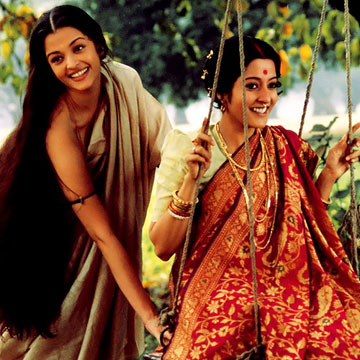 Bimala
Bimala lives under the shadow of her rich elite husband Nikhil. Despite being high-spirited, she has to remain subdued in the role of a traditional Indian housewife. With the arrival of her husband's friend Sandip, Bimala finds a new hope for fulfilling her aspirations and falls in love, disregarding social norms. That's Tagore's Bimala from "Ghare Baire".
Born in 1861 to Debendranath Tagore and Sarada Devi, Rabindranath Tagore started writing at the age of six and went on to become the first Indian -- and the first Asian -- to win the Nobel Prize for literature for "Gitanjali".
Known vividly for his vast collection of poems, prose, plays, stories and novels, Tagore put women in the forefront in his works to convey feminism very strongly.
Being a progressive thinker, his writings often were based on bold subjects that were far ahead of the time.
He strongly believed in fighting for women's upliftment using his pen as a weapon. Focusing largely on emancipation, his writing campaigned for women's liberation, equality, freedom, justice, power and dignity and rights.
Take Charulata of "Nashtanirh", a wife who remains secluded within the walls of her house and finds solace in her brother-in-law. Amal not just comforts her and bring out of boredom but also influences her to write for newspapers. Charu's confrontation with her husband about her inclination towards Amal shows how Tagore put boldness in his characters.
In "Noukadubi", Hemnalini refuses to marry her brother's friend after Ramesh, her love interest, marries another woman. Another protagonist Kamala in the same story, when discovering that the person she is staying with is not her husband, immediately abandons his home and goes searching for the person she was actually married to. The female characters are shown strong enough to stand for their rights.
Tagore took up the deprived life of a widow - Binodini - and her sexual emancipation in a love quadrangle tale "Chokher Bali". A story of distrust, adultery and lies, the novel also highlights the dictatorship of a patriarchal society where young girls were married off to much older men and left to become widows at an early age that caged their route to freedom.
Tagore brought into the forefront the sexual desires of a woman, which even today is considered taboo, reflecting his liberal approach to the topic.
"Shesher Kobita", probably his most lyrical novel, presents Labanya as a strong-willed, highly-educated, free-spirited woman who hails from a middle class family. A woman with high ethos, Labanya falls in love with Oxford-returned Amit. Though their love blossoms, Tagore, through Labanya, raises questions about the very institution of marriage as the ultimate goal of a love affair.
Tagore travels inside the traditional Indian concept of an arranged marriage through the life of Haimanti, the lead protagonist of the book of the same title. The story takes on the whimsicality and hypocrisy of the 19th and 20th century middle class society that restricts Haimanti's free spirit.
Taking another dig at the patriarchal rules that probably still persist, "Strir Patra" voices the struggle of self-identification that Mrinal faces in her life. The story revolves around a letter sent to a husband by his wife for the first time in 15 years conveying how her intelligence became a hindrance to her livelihood and led to misery, and how writing poetry gave her solace and made her feel free from the patriarchal bond. Through Mrinal, Tagore reflected how a woman's life was meant not to be restricted within the inner walls of a home.
Not just on pages, but Tagore's stories and novels have been brought alive a number of times on celluloid. Satyajit Ray went on to make a number of movies based on Tagore's writings. So did Rituparno Ghosh and the legacy is still being carried on by other directors.
What will be remembered forever about Tagore is his contribution to literary society and his attempt to create a world "where the mind is without fear and the head is held high".
 Bimala lives under the shadow of her rich elite husband Nikhil. Despite being high-spirited, she has to remain subdued in the role of a traditional Indian housewife. With the arrival of her husband's friend Sandip, Bimala finds a new hope for fulfilling her aspirations and falls in love, disregarding social norms. That's Tagore's Bimala from "Ghare Baire".
Bimala lives under the shadow of her rich elite husband Nikhil. Despite being high-spirited, she has to remain subdued in the role of a traditional Indian housewife. With the arrival of her husband's friend Sandip, Bimala finds a new hope for fulfilling her aspirations and falls in love, disregarding social norms. That's Tagore's Bimala from "Ghare Baire".